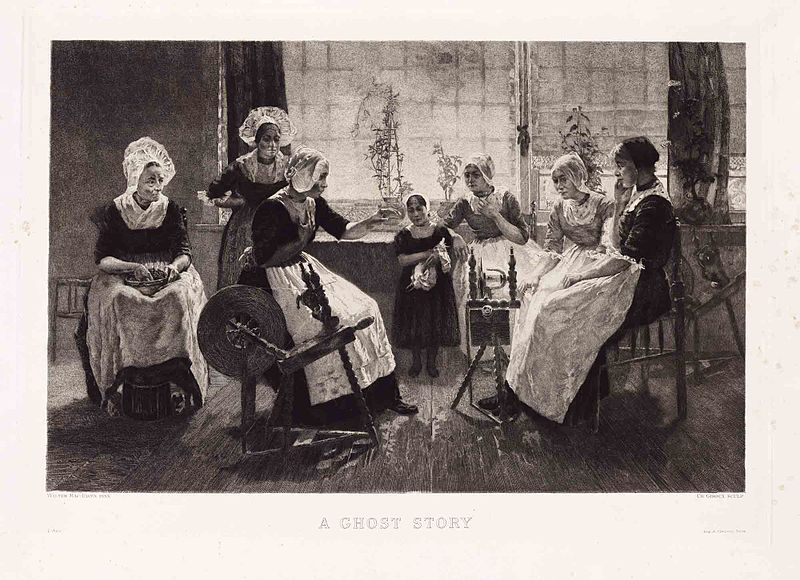 Recently, I was fortunate enough to gather with friends around a fire on a cool autumn evening. Through the crosshatch of trees, faint stars glistened in a cosmic tapestry whilst the scent of strong tobacco quickened the air. Cwrw dda, that is “good beer,” warmed our bodies. We had convened to this peaceful scene, a dozen or so of us, for the purpose of camaraderie and the reading of stories… ghost stories.
Recently, I was fortunate enough to gather with friends around a fire on a cool autumn evening. Through the crosshatch of trees, faint stars glistened in a cosmic tapestry whilst the scent of strong tobacco quickened the air. Cwrw dda, that is “good beer,” warmed our bodies. We had convened to this peaceful scene, a dozen or so of us, for the purpose of camaraderie and the reading of stories… ghost stories.
The first tale was read masterfully by Richard W. Rohlin, and the second by Joshua Alan Sturgill in his poet’s cadence. I am not able to replicate the third story, but for a happy reason. That tale, by Dr. Geoffrey Reiter, will soon be published in an upcoming collection. The available stories follow a brief introduction.
Though truncated, I have attempted to recreate this program in an electronic medium. It is a pale imitation of that night. Humans need community and experiences that are authentically lived, not merely mimicked flatly upon a screen. So rather than a simulation, this should be considered a set of suggestions.
The nights are longer now and colder. Put away the screen. Build a fire and sit with others. Tell a story.

An Brief Introduction for A Night of Ghostly Tales
(As read on that night.)
In North America, we are accustomed to think about ghostly and creepy tales during the fall, most especially at the end of October. However, in Merrie o’ England, the tradition for telling such stories occurs in winter, and somewhat counterintuitively, during Christmastime, often on Christmas Eve. This time of year… when families are reunited during the season of low winter sun and long cold evenings… well, it is a time quite conducive to the sharing of spine-tinglers.
The Rev. A. D. Crake wrote a collection of ghost stories appropriately entitled A Sheaf of Yule Log Stories which recounts experiences from his childhood in the 1840s. In the introduction, he writes: “These particular stories lie on the borderland between the seen and unseen; they may be very incredible; but they will serve to pass away the happy time around the Yule Log, when mythic stories are most acceptable.”
I’d like to add a theological slant to this tradition. During June, another great feast of historical Christendom is celebrated around midsummer: the Nativity of St. John the Baptist. On this holy day, we find traditions connected to fairy-lore, and to a lesser extent horror tales. In the New Testament, the Forerunner says: He must increase and I must decrease. So, St. John’s birth is celebrated at the brightest time of the year, yet the length of day is already beginning to decline. Six months later, at the darkest time of the year, we celebrate another birth, this time the Incarnation of the Son of God. And the length of day begins to increase. Darkness, which has no substance or existence of its own, is chased away.
I have no hard proof, and I personally don’t require any, but I believe that folkloric traditions naturally coincide with these cosmic and liturgical feasts. Our ancestors were closer to the natural order, and more in tune to the Church year.
As another priest and ghost story author, Sabine Baring-Gould once wrote: “Are we the happier for knowing that there are no ghosts, no fairies, no witches, no mermaids, no wood spirits? Were not our forefathers happier in thinking every lake to be the abode of a fairy, every forest to be a bower of yellow-haired sylphs, every moorland sweep to be tripped over by elf and pixie?”
Are we better off than our forefathers?
We have lost many things, but we may gather and help one another remember… to come to our senses and to our right minds. So, tonight, we have an opportunity to regain something. To sit across a campfire… prosopon to prosopon… face to face and tell one other stories again.
So, we’ll do that. First, we will listen to a tale by Thomas Graham Jackson, an architect who composed one collection of stories with the utilitarian title of Six Ghost Stories. Though little known, this small contribution to the genre is quite entertaining. Jackson consciously wrote in the Jamesian tradition, as we will discover.
Next, we will hear a story from the master, M. R. James, who at different times served as provost of Eton and Kings. He was also an experienced antiquarian who specialized in cataloging church libraries of medieval scripts. His translation of the New Testament Apocrypha is still well regarded, but he is best remembered as one of the foremost practitioners of the ghost story. In grand fashion, the master, held a select audience spellbound in his private chambers every Christmas Eve with a reading of a new story.
We will now begin…
